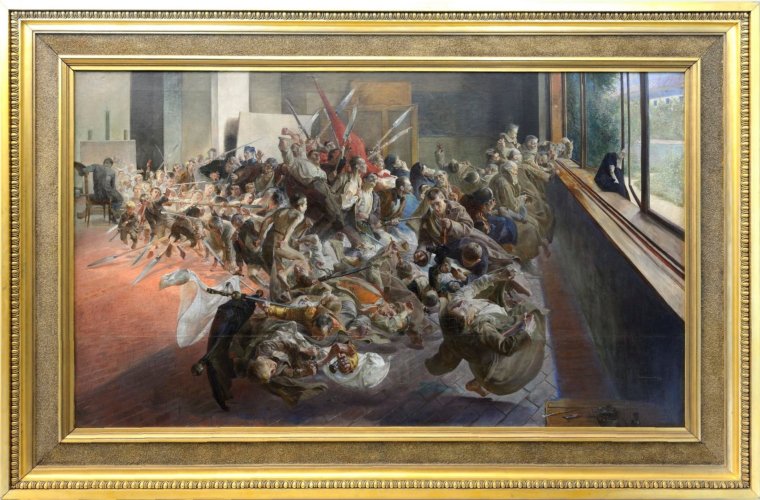Description:
Jacek Malczewski (1854-1929) had a love for art and romantic literature, particularly the poetry of Juliusz Słowacki, which he inherited from his family. He came from a noble, albeit impoverished, family. His father, Julian, supported him in pursuing a career in painting. The events of 1863 – the January Uprising and subsequent repression – left a lasting impression on the young artist. His first teacher was Adolf Dygasiński. During 1867-1871, he spent time at the Karczewscy dworku in Wielgie. In 1873, he began studying at the School of Fine Arts in Krakow under Jan Matejko. He was also a student of Władysław Łuszczkiewicz. He also studied at the École des Beaux-Arts in Paris. He traveled to Italy, Vienna, Munich, Greece, and Asia Minor. From 1896-1900 and 1910-1914, he was a professor at the Academy of Fine Arts in Krakow. From 1912-1914, he served as its rector. He began with a romantic realism, then shifted to naturalism. His works at this time often featured themes of exiles in Siberia and the inspiration of Juliusz Słowacki’s “Anhellim.” At the same time, his works began to take on a more fantastical and allegorical nature. After his father’s death in 1884, the theme of Thanatos, the god of death, began to appear in his works. After 1890, his art became more and more symbolic. His works “Introdukcja” (1890), “Melancholia” (1890-1894), and “Błędne koło” (1895-1897) are examples of this shift. He also tackled existential, historical, and artistic themes, weaving classical mythology and biblical themes with Polish folklore and landscapes. The form, color, monumentality, and expressiveness of his works became his trademark.
Description of the painting:
“Melancholia” is a programmatic work, a manifesto that defines the artist’s turn towards symbolism. It depicts a running, almost frenzied procession of figures emerging from the painting on the easel in the left part of the painting. The characters are a creation of the painter facing away from the viewer. In the colourful crowd, one can make out the halberdiers, soldiers and representatives of different classes. This is a truly Dantesque hell encased in the four walls of Malczewski’s studio and marked with the inscription: “Prologue. Vision, Last Age in Poland”. The painter’s main point of interest becomes the contemporary condition of the nation and its representatives, including artists, who have been assigned the role of special guides of the nation. The open window, behind which stands the titular Melancholia, can be read on the one hand as a desired and longed-for announcement of freedom, which the crowd strives for, and on the other – it becomes a symbolic border between the realm of earthly struggles and the eternal.
We are inside a painter’s studio. On the left, in the background we can see the figure of the creator with their back turned to us, sitting at an easel. Starting from the canvas, a procession of tightly packed men of various ages and with various attributes, starting with a scythe and ending with an hourglass, begins. We can recognize them from the painter’s previous works, as one of the most prominent art experts of that time – Stanisław Witkiewicz* – writes. Critics also mention the symbolic faces of three generations of enslaved Poles presented in the crowd. Among the possessed collective, we can distinguish the Kosynierzy of Kościuszko, Napoleon’s soldiers and the insurgents of 1863, as well as the later exiles to Siberia. The paths of the painted heroes seem to intersect in a pattern resembling a Latin cross. Ignoring the other companions of misfortune, they almost blindly run towards the open window on the right side of the representation. Next to it appears the silhouette of a woman in a black scarf. She does not look at the viewer. Her attention is focused on the expanse of green vegetation of the garden behind the glass barrier. Most likely, she is the personification of the title Melancholy, who is often also identified with Poland, grief and death**.
The work of Jacek Malczewski can also be interpreted in a wider, transnational context. It can present a symbolic representation of man’s struggles with the adversities that stand in his way and make it difficult or impossible for him to achieve his desired goal**. In this context, it is worth emphasizing the analogy between the three generations captured and the age of the figures arranged in a triad: young people, mature men and old people. Among them we can find representatives of the village, the intelligentsia, the clergy and even artists, painters and musicians. Melancholy thus becomes a symbolic representation of the earthly Vanitas and the inevitable passing of time.
The last, third interpretive field is related to the artist’s declared artistic worldview**. On the canvas we can see two painters. The one sitting at the easel seems not to notice the procession of visionary figures brought to life by him. The other is visible at the right edge of the canvas, next to a table with painting supplies, holding a palette and brush in his hands. He recklessly allowed himself to be carried away by the running crowd. Under his pressure, he even lost his balance. He was painted in the moment of the fall, which seems to be inevitable.


